Story time is back! After last week's field trip to the art museum, I thought it would be nice to read Sky Tree: Seeing Science Through Art by Thomas Locker.
by Thomas Locker.
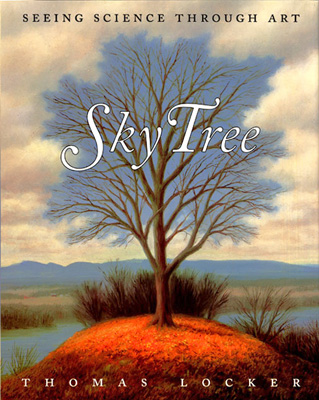
In the his introduction, Locker explains, "Through storytelling, art appreciation, and scientific exploration, Sky Tree attempts to reach both the heart and the mind." The following pages depict the same tree in the same location, but as the sky and the seasons change, the scene is transformed.
It all begins with a tree alone on a hill in the summertime.
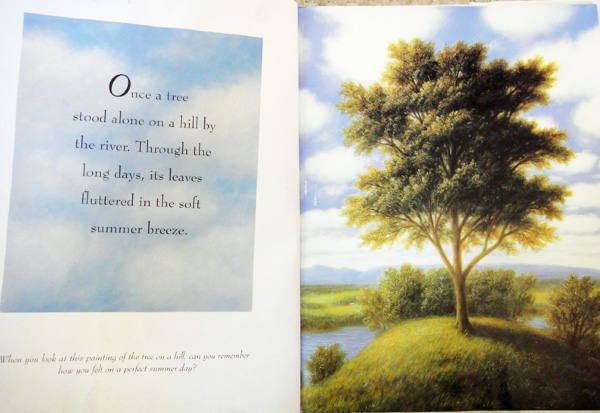
Locker asks, "When you look at this painting...can you remember how you felt on a perfect summer day?" He poses one question on each page to help kids think about how the painting makes them feel about the tree or the sky or the seasons. He encourages kids to really look at and experience the paintings, rather than just say, hey there's the tree again. (And isn't that what we do when we see trees every day: we walk on past without really looking at them?)
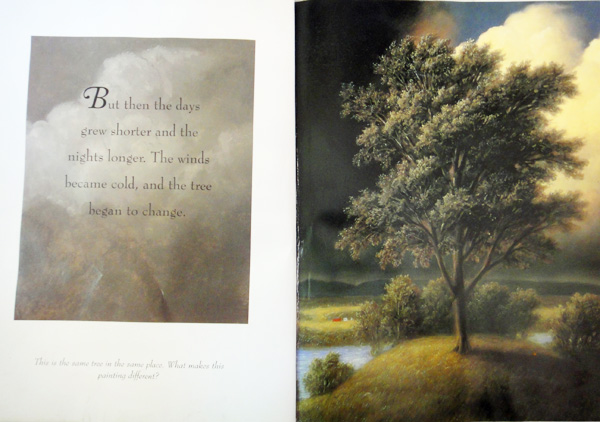
"What makes this painting different?" asks Locker. How has the tree changed? How has the sky changed? How would it feel to stand under this tree now? What do you think is going to happen next?
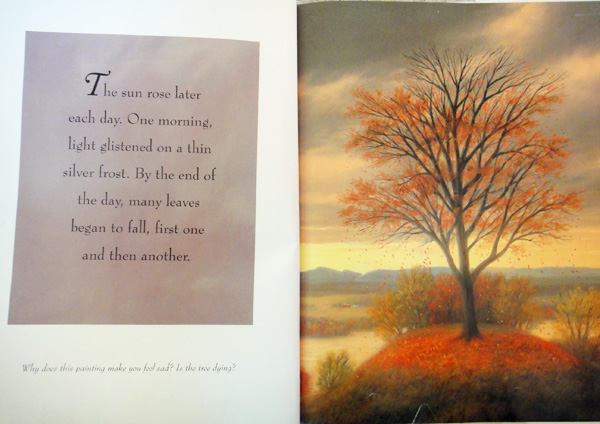
"Is the tree dying?" he asks. No, it's just losing its leaves like so many trees do in the fall. "Why does this painting make you feel sad?" Locker wonders. It is sad to see the leaves falling from the tree leaving only bare twigs behind, but we know they'll be back just like we know that spring and summer will be back. In time.
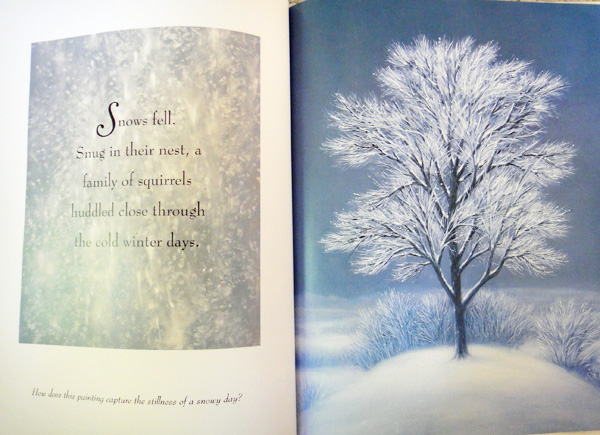
"How does this painting capture the stillness of a snowy day?" I love the quiet after a snowstorm when there no cars on the road and footsteps are silent in the snow. Don't you? I also love it when icicles form around the branches turning sleeping trees into crystal sculptures.
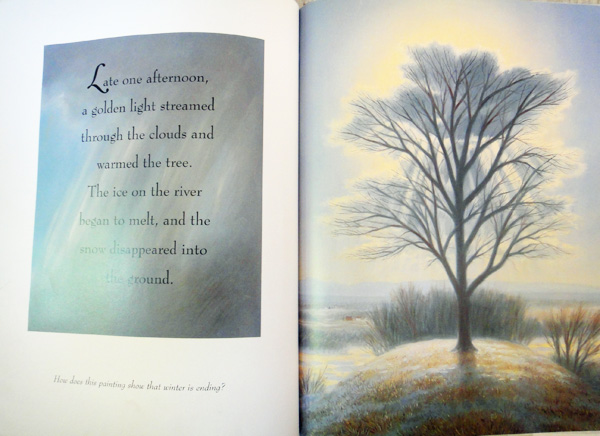
"How does this painting show that winter is ending?" Like the painting on the cover of the book, Locker really plays with the outline of the tree on the sky here. Although the tree is bare, the clouds behind it blocking the sun suggest the leaves that will soon be there to make shade for a picnic.
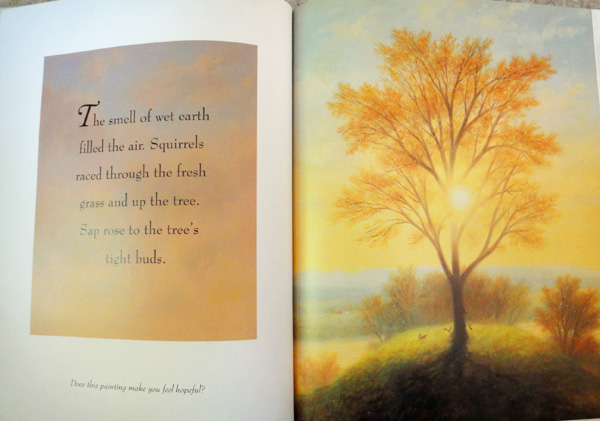
"Does this painting make you feel hopeful?" The sunrise here is beautiful. In the back of the book Locker briefly discusses each of the paintings. For this one he says, "This painting almost makes you squint." It's so true! It reminds me of studying my tree this spring. Looking up at the early leaves, I had to squint to see the new tiny bits of green in the bright sun.
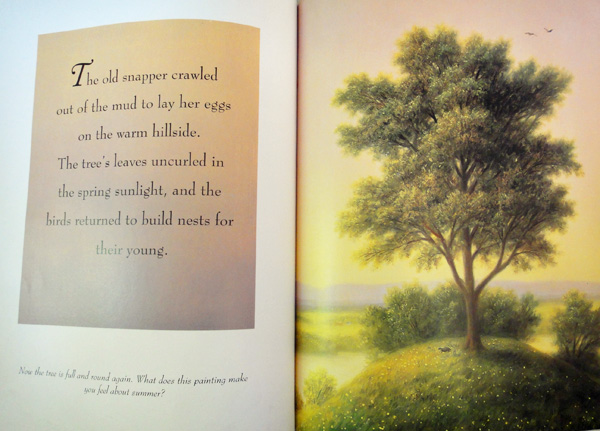
"Now the tree is full and round again." The tree has returned to the way it was on that first summer day. But is the picture exactly the same? Is the tree exactly the same from year to year? I wonder what has changed. How have you changed in the last year?
The final painting in the book is called the sunset tree. Locker uses it to talk about the connection between the tree and the sky, asking kids to think about why the book is called Sky Tree. The tree is painted entirely in shadow, so the focus shifts to the sky and its brilliant colors, full of light and power and magic.
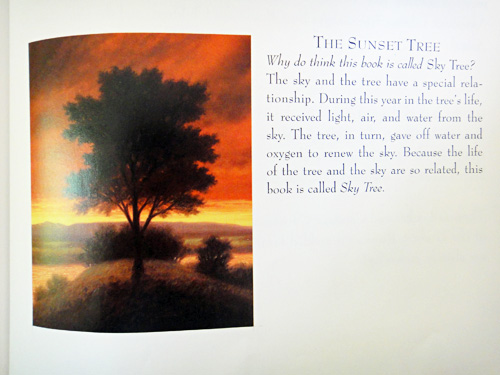
There's one more amazing image of trees and sky that you have to see! Check out Frans Lanting's photo of Camel Thorn trees from a recent issue of National Geographic. The surreal orange sky makes the photo look like a painting! This article talks about the photo and contains more stunning images from the same photographer. And there are even more photos of the beautifully strange landscapes in Namibia's Namib-Naukluft National Park here. (Thanks to Paul for the link!)

In the his introduction, Locker explains, "Through storytelling, art appreciation, and scientific exploration, Sky Tree attempts to reach both the heart and the mind." The following pages depict the same tree in the same location, but as the sky and the seasons change, the scene is transformed.
It all begins with a tree alone on a hill in the summertime.

Locker asks, "When you look at this painting...can you remember how you felt on a perfect summer day?" He poses one question on each page to help kids think about how the painting makes them feel about the tree or the sky or the seasons. He encourages kids to really look at and experience the paintings, rather than just say, hey there's the tree again. (And isn't that what we do when we see trees every day: we walk on past without really looking at them?)

"What makes this painting different?" asks Locker. How has the tree changed? How has the sky changed? How would it feel to stand under this tree now? What do you think is going to happen next?

"Is the tree dying?" he asks. No, it's just losing its leaves like so many trees do in the fall. "Why does this painting make you feel sad?" Locker wonders. It is sad to see the leaves falling from the tree leaving only bare twigs behind, but we know they'll be back just like we know that spring and summer will be back. In time.

"How does this painting capture the stillness of a snowy day?" I love the quiet after a snowstorm when there no cars on the road and footsteps are silent in the snow. Don't you? I also love it when icicles form around the branches turning sleeping trees into crystal sculptures.

"How does this painting show that winter is ending?" Like the painting on the cover of the book, Locker really plays with the outline of the tree on the sky here. Although the tree is bare, the clouds behind it blocking the sun suggest the leaves that will soon be there to make shade for a picnic.

"Does this painting make you feel hopeful?" The sunrise here is beautiful. In the back of the book Locker briefly discusses each of the paintings. For this one he says, "This painting almost makes you squint." It's so true! It reminds me of studying my tree this spring. Looking up at the early leaves, I had to squint to see the new tiny bits of green in the bright sun.

"Now the tree is full and round again." The tree has returned to the way it was on that first summer day. But is the picture exactly the same? Is the tree exactly the same from year to year? I wonder what has changed. How have you changed in the last year?
The final painting in the book is called the sunset tree. Locker uses it to talk about the connection between the tree and the sky, asking kids to think about why the book is called Sky Tree. The tree is painted entirely in shadow, so the focus shifts to the sky and its brilliant colors, full of light and power and magic.

There's one more amazing image of trees and sky that you have to see! Check out Frans Lanting's photo of Camel Thorn trees from a recent issue of National Geographic. The surreal orange sky makes the photo look like a painting! This article talks about the photo and contains more stunning images from the same photographer. And there are even more photos of the beautifully strange landscapes in Namibia's Namib-Naukluft National Park here. (Thanks to Paul for the link!)
